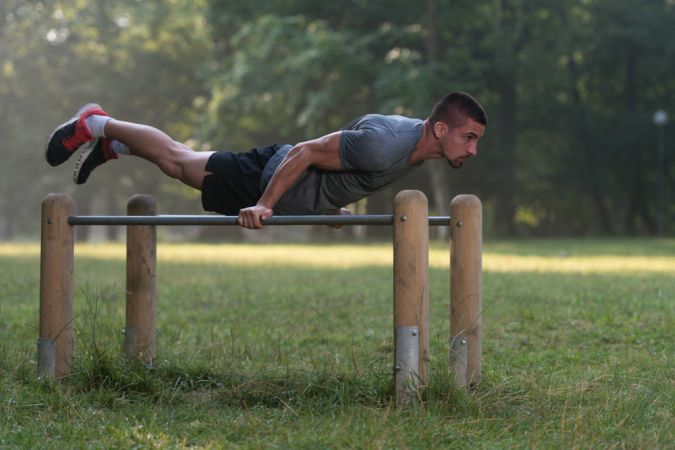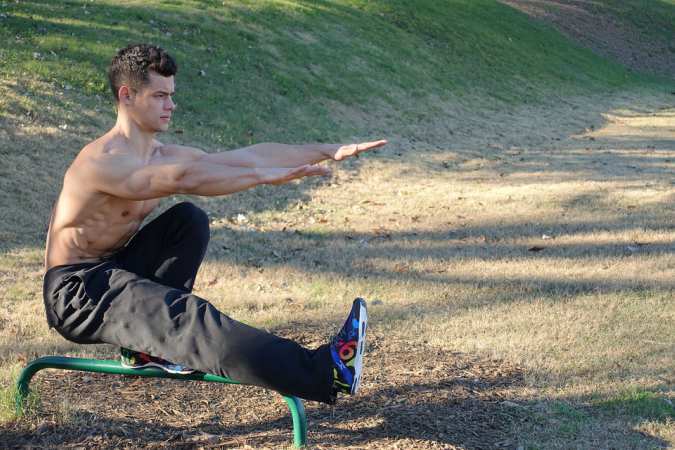Calisthenic training is a form of exercise where it uses no additional weight. It is also known as body-weight training, this can be done for weight loss, fitness or tone and achieve leanness. This has many benefits and is perfect for all levels of trainees, from beginners to advanced.
The main benefit is it helps to build muscular strength and endurance, and improves bone and joint strength. It can be performed anywhere. So if you’re a beginner, this training is perfect to help you develop co-ordination, stability and muscular control.
Advantages Of Calisthenic Training:
Performed anywhere: You can perform body-weight training almost anywhere, all you need is space and possibly some basic dip and pull-up bars. For an effective body-weight training workout this is perfect, as it can be performed inside or out.
Little Or No Equipment: Depending on your goal all you need is a bar or two. Not needing anything big and heavy allows for multiple possibilities.
Own Pace: The advantage of bodyweight training is not needing to wait for a specific machine or station, like you would at a traditional gym. Body-weight training not only saves time, it also allows you to train at your own pace.
Easily Adjustable: Body-weight training allows you to adjust and move in your own ranges of motion, also your specific arcs of movement.
Progression And Regression: With bodyweight training you can create progressions and regressions easily. For example:
- If you wanted to progress on the standard push-up, simply elevate your feet, slow reps, add some plyometrics or pause at the bottom of each rep.
- To regress on the same exercise, perform them on your knees, push-off from an elevated block with your feet on the ground or do half reps.

Benefits:
Build Strength: Calisthenic training will give you the feeling of full-body strength and control. Each body-weight exercise requires complete body control, stabilisation and co-ordination. Adding a few intensity techniques creates real, functional strength, nothing isolated.
Strengthen Weak Muscle Areas: A possible weak spot in your range of motion means body-weight training, will challenge your entire range and strengthen it. When performing a pull-up, for example, it stresses your:
- Lats.
- Rhomboids.
- Teres minor and major.
- Lumbar.
- Anterior.
- Medial.
- Posterior deltoids.
- Traps.
- Abdominal.
- Biceps.
- Forearms.
- Glutes.
It is clear to see the extensive benefits to bodyweight training.
Joint Rehab: Body-weight training also has a therapeutic effect on certain troubled joints. This training, when done with correct volume and frequency, can build and strengthen certain weaker joints. Performing full range of motion push-ups, pull-ups and squat movements, will move the joint in the full spectrum of its ability without heavy weight.
Lifelong Training: When you look at your physique goals where does real, practical, functional training fit in? Eventually you will still want to be able to run, jump, push, pull, drag and lift your own body weight with little regard to how much you bench. Body-weight training teaches you to connect with what your body is capable of achieving.

You can rely solely on calisthenic training if you’re looking to, lose weight or increase your fitness by completing:
- Four sessions per week: Two focusing on upper-body exercises and two focusing on lower body.
As well as the exercises listed below, you can add:
- Burpees.
- Mountain climbers.
- Planks.
- Crunches.
- Inverted rows.
- Lunges.
If you’re training for muscle size and strength, then calisthenic training should be done alongside your weight workouts:
- After three of your weights sessions every week, set up a calisthenic exercise circuit, containing four or five exercises, complete as many rounds as you can in 15 minutes.
The most well-known upper-body calisthenic exercises are:
- Push-ups: Push ups are great for building muscle in your chest, shoulders and triceps, but also improve your core stability and muscular endurance.
- Pull ups: Pull-ups work your back, biceps and grip, they are a great test of upper-body strength.
Why not try experimenting, for push-ups try T push-ups or clap push-ups? Using a stability ball or medicine ball, or even with just one arm? For pull-ups, change your grip width, or use a tree branch or gymnastic rings for balance and posture strengthening.
One of the most effective lower-body callisthenics is the squat:
- Stand with your feet slightly wider than shoulder-width apart, and your toes turned out about 10 degrees.
- Squat down by pushing your hips back and knees out, until you can go no lower, then stand back up again.
You can perform different variations by changing your foot placement and speed, one-legged squats, known as pistols, are a challenging variation that can increase your lower-body strength, balance and mobility.
- Lunges: Take a large step forward, then lower your body until your front leg is parallel to the floor. These are another effective body-weight calisthenic. This exercise targets your quads but uses a number of other muscles.
What You Need:
- Space: Depending on what you set out to do you will need ample space. For most bodyweight routines this may only require a small space. For advanced training you will need a slightly larger area.
- Minimal equipment: For those of you who want more of a challenge some minimal equipment might be required, just a bench and possibly a pull-up bar and something to do dips on.
- 30 minutes: Most bodyweight routines can take 30 minutes or less, but more if you want.
- An open mind: Keep an open mind about what you can do with bodyweight training, adjust when you need to and increase your intensity when comfortable.
The Basic Exercises:
Below is a list of the basic exercises. Most are familiar and easy to perform. Warm-up properly with some burpees or jumping jacks before starting your workout. Always use correct form and technique throughout each exercise.
- Push-up.
- Pull-up.
- Inverted row.
- Parallel bar dip.
- Prisoner squat.
- Lunge.
- Step-up.
- Calf raise.
- Leg raise.
- Sit-up/crunch.
- Plank.
Intermediate Alternatives:
When you reach a certain level of conditioning and strength you will need and want some new exercises. Below are a few alternative ways to push harder and keep your gains increasing.
- Feet-elevated push-up.
- 3-way push-up (feet-elevated, flat, then hands elevated).
- Chest-to-bar pull-up.
- Feet-elevated inverted row.
- Pike press.
- Pistol squat.
- Bulgarian split squat.
- Walking lunge.
- Reverse lunge.
- Windshield wiper.
- Hanging leg raise.
- 3-way plank.
Intensity:
Below are a few exercises to add to your bodyweight routine for added intensity. These can be used at the end or in between sets of other exercises to increase your work output.
- Burpees.
- Sprint intervals.
- Shuttle runs.
- Sled drag – push/pull.
- Jumping jacks.
- Jump rope.
- Box jumps.

The Callisthenics Workout Programmes:
Below are two programmes (basic and intermediate) that you can perform three or four times per week. These can also be added to your current training programme to strengthen a weak area or for added volume or frequency.
Basic Workout:
Perform the following programme three or four times per week. Allow correct form and rest is after all supersets have been completed.
| Basic Bodyweight Workout | |||
|---|---|---|---|
| Perform 3-4 x a Week | |||
| Exercise | Sets | Reps | Rest (sec) |
| Superset: Push-up and pull-up | 2-4 | 10-20 | 60 |
| Superset: Parallel bar dip and inverted row | 2-4 | 10-20 | 60 |
| Superset: Prisoner squat and forward static lunge | 2-4 | 10-20 | 60 |
| Superset: Step-up and single leg calf raise | 2-4 | 10-20 | 60 |
| Triset: Lying leg raise, floor crunch and plank | 2-4 | 10-20 | 30 |
Intermediate Workout:
Perform the following programme three or four times per week. Allow correct form and rest is after all supersets have been completed.
| Intermediate Bodyweight Workout | |||
|---|---|---|---|
| Perform 3-4 x a Week | |||
| Exercise | Sets | Reps | Rest (sec) |
| Superset: 3-way push-up and chest-to-bar pull-up | 3-5 | 10-16 | 60 |
| Superset: Feet-elevated inverted row and burpees | 3-5 | 10-16 | 60 |
| Superset: Pike press and jumping jacks | 3-5 | 10-16 | 60 |
| Superset: Bulgarian split squat and reverse lunge | 3-5 | 10-16 | 60 |
| Superset: Box jumps and sled drag – push/pull or sprint intervals | 3-5 | 10-16 | 60 |
| Triset: Hanging leg raise, 3-way plank and jump rope or mountain climbers | 3-5 | 10-16 | 30 |




